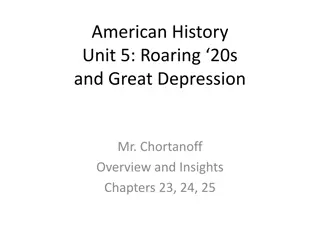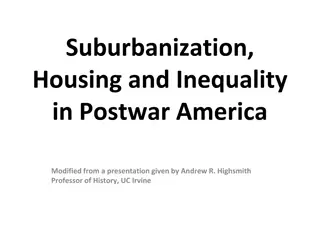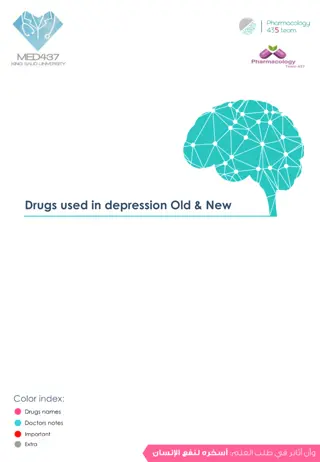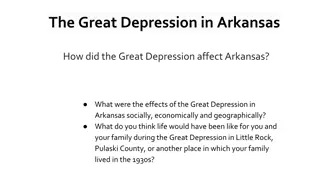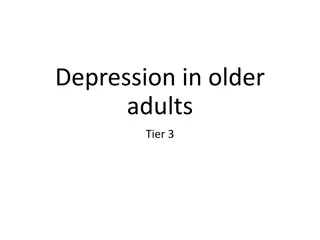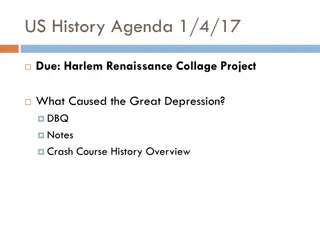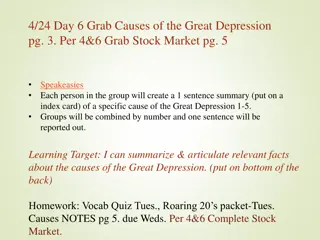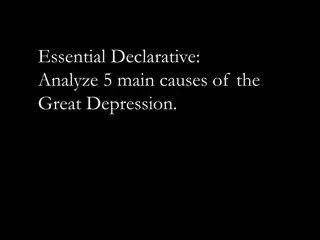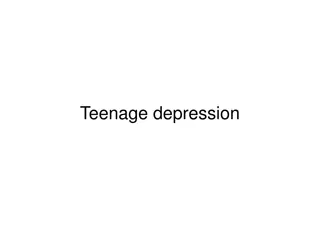The Great Depression: Causes and Impact on Postwar Prosperity
Postwar prosperity crumbled into depression by the end of the 1920s due to various factors including the destruction of European farmland during the war, protectionist policies, market speculation, and panic leading to the stock market crash. The ripple effect of risky loans, bank failures, cuts in production, and rise in unemployment resulted in a worldwide depression by 1932 affecting millions of workers in industrialized countries.
Download Presentation

Please find below an Image/Link to download the presentation.
The content on the website is provided AS IS for your information and personal use only. It may not be sold, licensed, or shared on other websites without obtaining consent from the author.If you encounter any issues during the download, it is possible that the publisher has removed the file from their server.
You are allowed to download the files provided on this website for personal or commercial use, subject to the condition that they are used lawfully. All files are the property of their respective owners.
The content on the website is provided AS IS for your information and personal use only. It may not be sold, licensed, or shared on other websites without obtaining consent from the author.
E N D
Presentation Transcript
END OF PROSPERITY Postwar prosperity turned to depression by end of 20 s. European farmland destroyed during the war. Farmers in Africa, Australia, India, New Zealand, NA, and SA increased food production to sell to Europe. Took out loans for machinery and additional land. Worldwide demand for crops and prices dropped: Debt crisis
PROTECTIONISM Nations protected foreign industries from competition by limiting trade Est. tariffs on imported good-Failed policy Ex: Hawley-Smoot Tariff: highest import tax in history (Made it difficult for Europeans to sell their goods in the United States) Could not purchase goods or pay off their debts American bankers: loaned money to Europeans to buy US goods
SPECULATION AND PANIC Market Speculation-Stock market investments 1920 s buying on margin: borrow money to purchase goods Value of Stock rises-stocks sells-loans repaid-Value falls-loans aren t repaid Black Thursday: Stock market closed on Wednesday, October 3rd and Down Jones dropped 21 points in an HOUR. Thursday: worried investors begin to sell and stock prices fall dramatically. Ex: General Electric: bought at 400, sold 283 Banks pulled money to buy stock to stabilize prices
Black Tuesday: October 29th, record of 16.4 million shares sold compared to average 4-8 million (Great Crash). By November 13th- Dow Jones fell from 381 to 198.7 Overall losses: $30 billion dollars.
RIPPLE EFFECT Risky loans hurt banks: banks loan huge sums of money to many high- risk businesses. When stock prices fell, these businesses were unable to repay loans. Bank Runs: Fear that banks would run out of money. People would run to banks to withdraw as much money from their accounts. To pay deposits, banks demanded loans. Loans were not paid, therefore, money could not be given. Bank Failures: unpaid loans + bank runs= bankrupt Savings wiped out: bank failures wiped out savings Cuts in Production: Businesses could not borrow money to produce more goods. Lacked incentive to spend money. Rise in Unemployment: cut back on production, laid off workers. Further cuts in Production: unemployment grew and incomes shrank, consumers spent less and less money produced still fewer goods. 1. 2. 3. 4. 5. 6. 7.
WORLDWIDE DEPRESSION By 1932, more than 30 million workers in countries in industrialized world could not find jobs. Economic Nationalism made the Depression harder to recover from
Great Britain (Great Slump) http://t1.gstatic.com/images?q=tbn:ANd9GcS0UoPbsTeeoE9JnJRCzlcOA7cclfB1rfHds8TGmb2lhKl6SMVwoA 1. Suffering turmoil of war and never recovered by GD. 2. Relied highly on exports to other countries (No Buyers) 3. Create jobs by granting low-interest loans to industries. 4. Raised tariffs against foreign goods 5. Relied heavily on reparations from Germany France 1. Underdeveloped Economy http://t0.gstatic.com/images?q=tbn:ANd9GcSneDFLKQoglMCMCDEsOnqn2nwpePCdB6o2Bvz5iscOsjGgdymI 2. Farming and Tourism (No Money for tourists to visit). 3. Relied heavily on Reparations from Germany
Germany: 1. Had to pay reparations to other countries like France and Great Britain 2. Currency had to be printed constantly (Currency becomes worthless) 3. Savings were wiped out 4. Adolph Hitler (Begins to fade): German production: munitions/arms manufacturing rather than consumer goods. Japan: 1. Deficit Spending: govt will spend more than the income it makes. 2. Yen was intentionally lowered 3. Exports such as textiles were substantially lower than UK or France. 4. Worried more about Economy overgrowth Soviet Union: 1. Lack of participation in capitalism (Barely affected by Depression)
NEW DEAL 1932: FDR elected president of the United States Relief, Reform, and Recovery Only thing to fear is fear itself Granted money to states to provide clothing, food, and shelter Government began a program of public works (Buildings, roads, and other projects) Social Security Act: unemployment and old age benefits 40 hour workweek and minimum wages Right to from unions WW2 ends Depression for all countries






